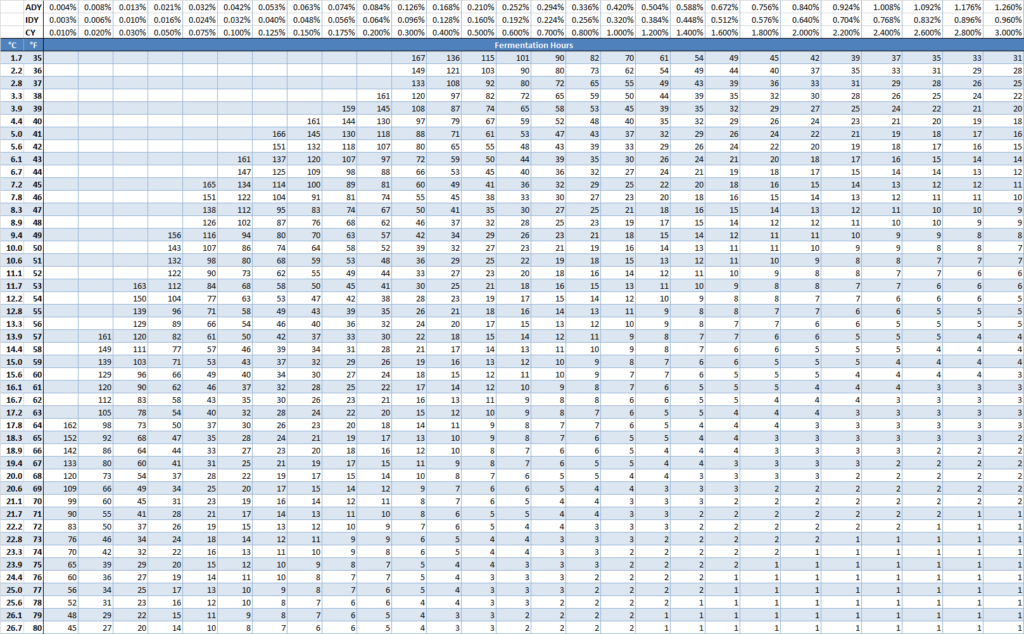
Even though I live in New York City, a place with more pizza than any one person can eat, I still enjoy making it at home. I don’t stick to a single recipe because my purpose is to understand more about the nature of flour, salt, water, yeast, and everything else that can effect a pizza crust. Professional pizza makers spend the vast majority of their time perfecting their dough because it’s the one component of pizza that’s a moving target. Sourcing good tomatoes and cheese doesn’t take long. The right pepperoni is always going to be the right pepperoni. But pizza dough is alive. It’s constantly in motion. That’s why it’s the obsession of every pizza maker.
Time and Temperature
Most internet pizza dough recipes are the same. They tell you to use warm water and loads of yeast so you can get down to pizza making the same day. Yeast works faster when it’s warm and slower when it’s cold. The problem here is that rushing the fermentation process will result in flat tasting, heavy crust that doesn’t brown in the oven. These recipes usually add a bunch of sugar to provide that browning. Making your dough with lower temperature water and less yeast lengthens the dough maturation process, which will give you a lighter pizza crust with better flavor. I usually do a 2-3 day fermentation in the refrigerator, which is what we teach in our online pizza making classes. It’s a great recipe, but takes up a lot of room in the refrigerator.
With this recipe, you’ll leave the dough out at room temperature for about 30 hours. I was inspired to try it because I saw some great looking pies on Instagram posted by @akpizzaguy, a home pizza maker based in Seattle. He’s active on an incredible forum called PizzaMaking.com, where members often talk about dough techniques. I remember a few years back I saw a chart made by a member called TXcraig1 that maps out the amount of yeast needed for various fermentation times and ambient temperatures. I’ve used the chart as a reference for my refrigerated dough recipes but never explored its extremes.

How to Use this Recipe
I’m going to give you this recipe in a couple different formats. First, I’ll give you the actual measurements for each ingredient by weight. This is pretty important because measuring by volume (cups and spoons) will be inaccurate. I’m not giving you the recipe in cups and spoons. It’s best to have a scale that gets down to 0.01 grams. Here’s the one I use. I also use a larger scale for heavier things that don’t need as much precision. I’m also going to give you the recipe expressed as percentages. This is a method called Bakers Percentage. Bakers use this format to express each ingredient as a ratio of the amount of flour in the recipe. This way it’s easy to compare two dough formulas without having to factor in the different sizes of each batch. It also makes altering the recipe much easier because you can just nudge a percentage point.
I also want to point out that I’m using the word “recipe” against my will. I’d rather use the word “formula” because it makes clearer the fact that all the components are changeable. I’m calling it a recipe just so it’s a little easier to understand.
Pizza Dough Recipe
This pizza dough recipe will get you 4 dough balls weighing about 275g each. Use cold water. Either refrigerate some water for a couple hours or add a bunch of ice. You’ll want your water to be pretty cold, especially if your kitchen is warm. I list below to use Bread Flour. It’s fine to use All Purpose, but the dough will be stickier and harder to work with. Sticky dough is great, but might be more trouble than it’s worth if you’re not experienced.
| Ingredient | Weight | % |
| Bread Flour | 635g | 100 |
| Cold Water | 425g | 67 |
| Instant Dry Yeast | 0.10g | 0.016 |
| Fine Sea Salt | 19g | 3 |
| Sugar | 7.5g | 1.2 |
| Olive Oil | 13g | 2 |
The Method
Weigh everything out first! This way you can add portions of each ingredient without losing track.
Start by adding the water to your mixing bowl. Hold about 20g on the side because you’ll add that later. I use my hands to mix but you might use a stand mixer. You can do either. Next add 75% of the flour and start to mix. If using a machine, start on the lowest setting. When half of the flour is incorporated, add the yeast, salt, and the remainder of flour and continue to mix. Trickle in about half of the water you’ve reserved to help these new ingredients get incorporated. Once everything is combined, sprinkle in the salt as the mixer is in motion and trickle in the last of your water.
Oil is last because it inhibits gluten formation. The dough mixer will knead your dough to build strength and you want that to happen before oil gets in the way. Once the dough is a well-formed ball with all the flour, water, salt, yeast, and sugar you can crank the mixer speed up a notch and drizzle in the oil. Add it to the center of the dough ball otherwise it will just coat the bowl and your dough will flop around in there. Knead in all the oil a little bit at a time until you don’t feel it anymore.
You’ll want to keep kneading until the dough is smooth and bouncy. If you’re not seeing that after 5-10 minutes, cover the dough and give it a 10 min break. When you come back and continue to knead, it should get smooth pretty fast. Once the dough is done, just cover it and let it rise at room temperature for 24 hours. The next day, you can ball up the dough about 6-8 hours before you want to use it and the dough should be slack and ready for you.
Baking the Pizza
There are infinite ways to bake a pizza but I’ll give you the rundown on how I did the pie in the photo above. First I preheated a pizza stone in the oven at 500°F for 60 minutes. Crank your oven to its hottest setting for this step. I places my pizza stone (I actually used a Baking Steel) about 6 inches below the top of my oven so I could employ the broiler during the bake. Once the stone is hot, I coat my dough in flour and stretch it out by pressing down with the pads of my fingers. When it’s large enough to get my hands under, I lift the dough with my knuckles just barely within the edge of the dough, lifting to let gravity do the real work. If they dough is relaxed enough, this should happen pretty easily.
Once stretched, place the dough on a lightly floured pizza peel or cutting board. Lately I’ve been using roughly sliced mozzarella on the dough first before toppings. The last thing I add are dabs of tomato sauce. Before launching the pizza onto the stone, I check to make sure the pie isn’t stuck by gently jiggling it. Once I see it’s moving, I head to the oven.
This is where it gets fun. I start the bake by flipping on the broiler. This gives me a ton of heat from the top of the oven. My broiler clicks off when it overheats, so I let it run for 3 cycles, rotating the pizza 30% each time the flame turns off. After that, I put the oven back on its “bake” setting and let it ride until the pizza is almost done. Then at the very end, I click the broiler back on and finish the bake. That’s it!

